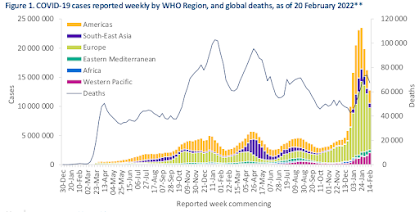#16,594
Following sharp, but relatively brief, surge in global COVID cases (see chart above) due to the emergence of a more transmissible Omicron variant last November, the latest WHO COVID Epi report shows most of the world (with the exception the Western Pacific Region) reporting a decline in cases, and deaths.
Global overview
Data as of 20 February 2022
Globally, during the week of 14 through 20 February 2022, the number of new COVID-19 cases decreased by 21% as compared to the previous week. In addition, the number of new deaths showed a decreasing trend (-8%) when compared to the previous week (Figure 1). Across the six WHO regions, over 12 million new cases and over 67 000 new deaths were reported (Table 1). As of 20 February 2022, over 422 million confirmed cases and over 5.8 million deaths have been reported globally.
At the regional level, the Western Pacific Region reported a 29% increase in the number of new weekly cases, while all other regions reported decreases: the Eastern Mediterranean Region (-34%), the Region of the Americas (-29%), the European Region (-26%), the African Region (-22%) and the South-East Asia Region (-17%).
The number of new weekly deaths increased in the Western Pacific (+21%) and African (+20%) Regions and decreased in the South-East Asia (-37%), the Regions of Americas (-9%), the European Region (-5%) and the Eastern Mediterranean Region (-4%).
The highest numbers of new cases were reported from the Russian Federation (1 236 910 new cases; -7%), Germany (1 218 465 new cases; -8%), Brazil (773 353 new cases; -23%), the United States of America (746 129new cases; -39%), and the Republic of Korea (612 195 new cases; +80%).
The highest number of new deaths were reported from the United States of America (14 723 new deaths; -6%), Brazil (5877 new deaths; -11%), the Russian Federation (5252 new deaths; +8%), India (3238 new deaths; -51%), and Mexico (2221 new deaths; +8%).
While a lot of people appear to be pinning their hopes on this last wave being the `last wave', there is a relatively new subvariant of Omicron - dubbed BA.2 - which is gaining ground, and attention, around the world.
Yesterday, in WHO Statement On Omicron BA.2 Sublineage, we looked at some of the recent studies and a brief WHO assessment on this emerging variant.
This latest report contains a more detailed report on Omicron. I've only posted some excerpts, so you'll want to follow the link to read it in its entirety.
This section provides a summary of the potential impact of the Omicron variant. Detailed information on this variant and related recommended priority actions for Member States can be found in the updated Technical Brief and Priority Actions for Member States as well as under the Country and Technical Guidance – Coronavirus Disease (COVID- 19). Based on the currently available evidence (Table 2), the overall global risk related to the Omicron variant remains very high.
Since the first reporting of the Omicron variant in November 2021, almost 1.5 million sequences have been deposited in GISAID. By the first week of January 2022, Omicron accounted for 90% of submitted sequences; by week five, Omicron had largely replaced all other variants and now accounts for over 99% of submitted sequences. Amongst the major Omicron lineages, BA.1 predominates overall, followed by BA.1.1 and BA.2, with BA.3 being the least frequently detected.
Weekly trends (figure 4, panel A) show that the relative proportion of BA.2 has increased over time, becoming the second most frequently detected lineage after BA.1.1 by week 6, and the dominant lineage in 18 countries. This trend is most pronounced in the South-East Asia region, followed by the Eastern Mediterranean, African, Western Pacific and European Regions.In contrast, very little BA.2 has been detected in the Americas, and no growth has been observed for the BA.3 lineage. Increased sequence variation has been observed within the BA.1 and BA.2 lineages over time, in line with increasing transmission.
The weekly number of Omicron sequences has been steadily decreasing since the beginning of 2022 (figure 4, panel B). This trend should be interpreted with some caution, as data for the most recent weeks may be incomplete due to the delay between specimen collection and submission of sequences to GISAID (median delay from week 1 of 2022: 13 days). In addition, some countries may have changed their testing and sequencing policies during the presented period.


